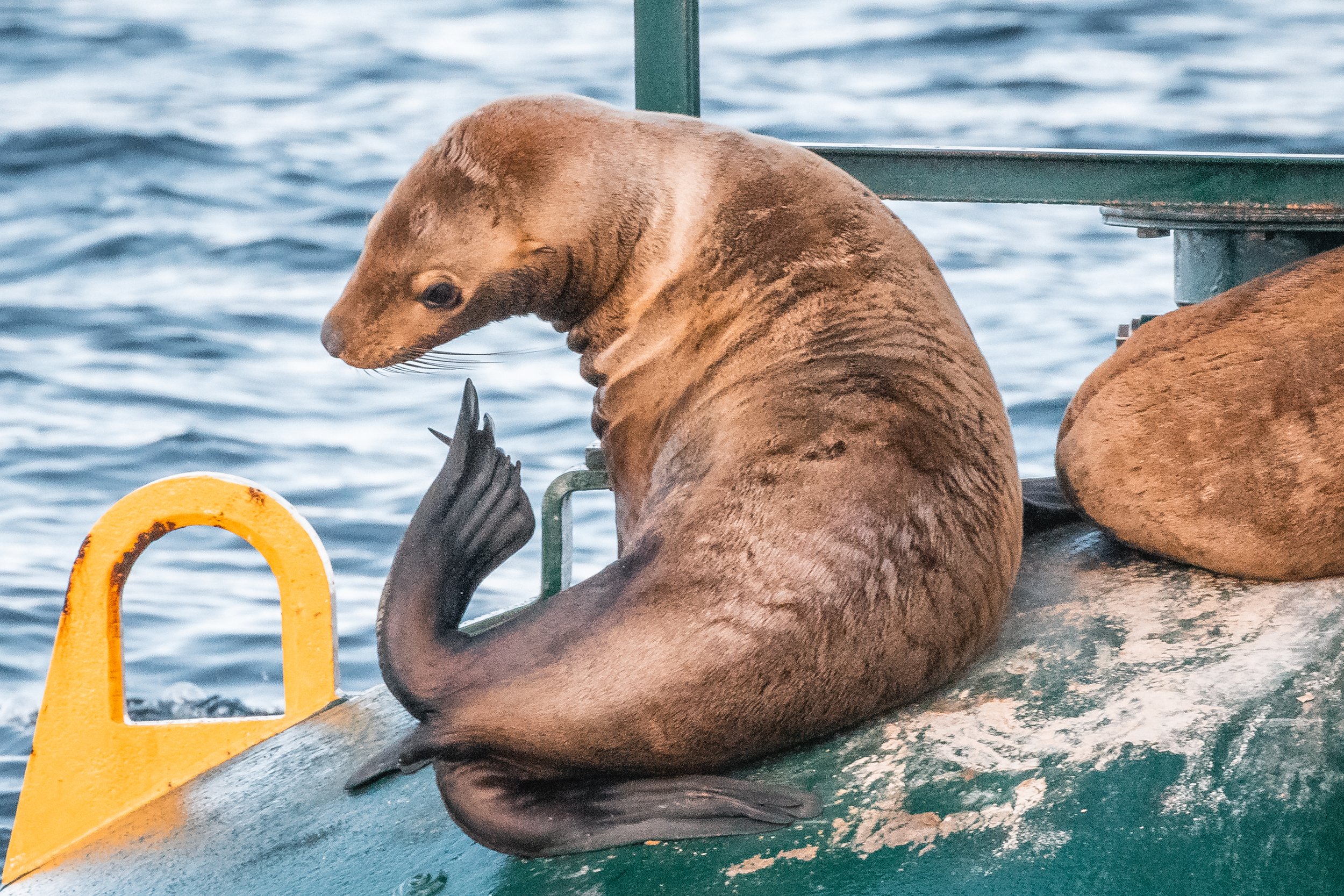June 29, 2022, 3:30 PM - T137's, T036A's + T065A's
This afternoon our tour took us up to the Lantzville area where we found a Transient killer whale T-party consisting of the T036A’s, T065A’s, and the T137’s. The current matriarchs for these pods are Leland for the T036A’s, Artemis/Fingers for the T065A’s, and Loon for the T137’s. Leland and Loon are suspected to be sisters, but these two matrilines typically travel separately. Every once in a while they come together and have a family gathering alongside their mother T036 Flapjack.
During our trips we see Steller Sea Lions hauled out on rocks and buoys as they warm up in the sun. Sea lions are skilled predators, preying on over 50 different species of fishes and invertebrates including Pacific Hake, Pacific herring, octopuses, and squid. They will also occasionally prey on Harbour seal pups and gulls. While they have excellent eyesight, sometimes the water they feed in is murky and it is hard to see, that’s where their whiskers, or more technically called vibrissae, come into play. Pinnipeds (seals, sea lions, and walruses) have some of the most sensitive whiskers of all mammals and they are also the longest of all mammals and can be up to 30cm long. Their whiskers are shaped differently than land mammals, instead of being round, their whiskers and seal’s whiskers are oval. This shape and orientation of their whiskers are important as it affects how much they vibrate. The whiskers are attached to a lot of nerves that “translates” these vibrations and allow them to “feel” their surroundings. Their whiskers are extremely sensitive to vibrations created by the wake of their prey as they swim and they can sense prey that is up to 180m away and can even detect which direction and the speed at which their prey is travelling. They will also use their whiskers like fingers, digging into the sediments moving them forwards and backwards “feeling” for bottom fish such as flounders, rockfish, and skates. Their bodies are fusiform shape (torpedo-shaped) creating a very streamlined body which reduces drag as they swim through the water. When they chase prey they can swim up to 40 km/h (25mph) using their front flippers to move them forward and using their hind flippers to steer them.
Enjoy the photos taken by our naturalists Vanessa Vereschahen and Janine Van Der Linden.
Amira (T065A3) and a young one. Photo by marine naturalist Vanessa Vereschahen
The Salish Heron ferry travels between Tsawwassen and the Southern Gulf Islands. Photo by marine naturalist Vanessa Vereschahen
Our semi-covered boat Kula. Photo by marine naturalist Vanessa Vereschahen
The little external ear (pinnae) visible just behind the eye. Photo by marine naturalist Vanessa Vereschahen
Gabriola bluffs carved out by erosion. Photo by marine naturalist Vanessa Vereschahen
A lot of orcas are easy to ID due to visible markings, but this one was hard to ID. Photo by Janine Van Der Linden
What a pointy dorsal fin. Photo by Janine Van Der Linden
Sun illuminating the blow of the orcas. Photo by Janine Van Der Linden
Amira (T065A3) far right, Artemis/Fingers (T065A) middle, and an unidentified individual. Photo by Janine Van Der Linden
Wake being formed by surfacing of the orca. Photo by Janine Van Der Linden
A beautiful view of the dorsal side of the orca. Photo by Janine Van Der Linden
Male dorsal fins can be up to 6ft long. Jack (T137A). Photo by Janine Van Der Linden
Jack’s (T137A) dorsal fin with it’s 2 identifiable notches. Photo by Janine Van Der Linden
The eyepatch and the dorsal fin are used to ID Jack (T137A). Photo by Janine Van Der Linden
Side view of Jack’s dorsal fin. Photo by Janine Van Der Linden
You can clearly see the two notches on the dorsal fin of Jack (T137A). Photo by Janine Van Der Linden
Small flattened tail seen between the hind flippers. Photo by Janine Van Der Linden
Lying on top of each other to warm up. Photo by Janine Van Der Linden
Look at my long whiskers. Photo by Janine Van Der Linden
Glaucous-winged Gull relaxing on the buoy. Photo by Janine Van Der Linden




















